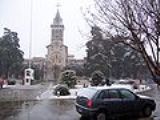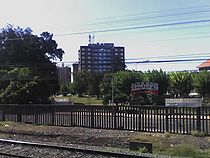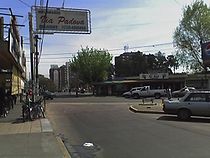
San Antonio de Padua
Encyclopedia
San Antonio de Padua, or plainly Padua, is a city in the Greater Buenos Aires
, in Argentina
. It is located in Merlo (Partido)
. The city has an area of 6.25 km² (2 sq mi) and a population of around 38,000.
The name commemorates the village founded by Francisco de Merlo, Villa San Antonio del Camino in 1755, named for the Portuguese saint Anthony of Padua
.
The city is on one of the major rail and road arteries and is well connected to the most important cities of the western Greater Buenos Aires.
Padua is bordered by the partido of Ituzaingó
(north and east), Merlo
(west and southwest) and Libertad (south).
Padua is basically a flat, low-rise city, with few buildings over two stories, so the skyline is still dominated by the spire of the Church of San Antonio de Padua. The building emerges in the center of a peaceful middle-class neighborhood of white-painted and red-barrel-tiles-roofed houses. The church was inaugurated in 1931 and few years later a Franciscan
monastery and a catholic school were erected at its side. The church was built in a Romanesque style
and is one of the Padua’s landmark buildings.
The commercial center is around the main avenue, Avenida Noguera, stretching six blocks from the railroad station, Estación San Antonio de Padua to the east.
The city status was conferred on September 11, 1974 by the Buenos Aires (Province) Legislature.

 The present-day territory of Padua was pasture
The present-day territory of Padua was pasture
until the 1920s.
This area —between the towns of Ituzaingó
and Merlo
— was filled with many farm
s when members of the British
community founded the Ituzaingó Golf Club in 1919.
The golf
club took its name from the nearby town of Ituzaingó and almost all of its first members were white-collar worker
s of the British-owned railway company Buenos Aires Western Railway Co.
that operated the Once
-Moreno
railway line from 1890 to 1946.
In order to reach the golf course
the company opened a railway stop in 1923, just 10 meters from the club house. In the opening ceremony participated members of the catholic clergy
and the railway stop was consecrated to Saint Anthony of Padua.
Through the next years the railway stop and the surrounding town were known as San Antonio de Padua.
The town started in the 1930s with the first houses built around the railway station and the opening of the parish church
in 1931; San Antonio de Padua grew steadily over the decades and it bloomed in the 1950s.
In the 1970s the commercial district of San Antonio de Padua —built around the main street Avenida Noguera and next to the railway station— became the most important commercial district in the entire partido
of Merlo.
, hockey
, tennis
and rugby
. In 1995 the rugby team competed in the first division of the Buenos Aires Rugby Union (URBA) championship.
Greater Buenos Aires
Greater Buenos Aires is the generic denomination to refer to the megalopolis comprising the autonomous city of Buenos Aires and the conurbation around it, over the province of Buenos Aires—namely the adjacent 24 partidos or municipalities—which nonetheless do not constitute a single administrative...
, in Argentina
Argentina
Argentina , officially the Argentine Republic , is the second largest country in South America by land area, after Brazil. It is constituted as a federation of 23 provinces and an autonomous city, Buenos Aires...
. It is located in Merlo (Partido)
Merlo Partido
Merlo is a partido of Buenos Aires Province, Argentina. It is located in Greater Buenos Aires, Argentina, west of the city of Buenos Aires. Its capital is the city of Merlo....
. The city has an area of 6.25 km² (2 sq mi) and a population of around 38,000.
The name commemorates the village founded by Francisco de Merlo, Villa San Antonio del Camino in 1755, named for the Portuguese saint Anthony of Padua
Anthony of Padua
Anthony of Padua or Anthony of Lisbon, O.F.M., was a Portuguese Catholic priest and friar of the Franciscan Order. Though he died in Padua, Italy, he was born to a wealthy family in Lisbon, Portugal, which is where he was raised...
.
The city is on one of the major rail and road arteries and is well connected to the most important cities of the western Greater Buenos Aires.
Padua is bordered by the partido of Ituzaingó
Ituzaingó Partido
Ituzaingó is a partido in the Gran Buenos Aires urban area, Argentina, 10 kilometres west of Buenos Aires city. It has an area of and a population of 168,419 . Its capital, the city of Ituzaingó, and the other districts currently in Ituzaingó Partido were part of the Morón Partido until...
(north and east), Merlo
Merlo, Buenos Aires
Merlo is the head town of the eponymous partido of Merlo and seat of the municipal government, located in the Greater Buenos Aires urban area.The city was founded by Francisco de Merlo in 1755 and rebuilt by Juan Dillon in 1859....
(west and southwest) and Libertad (south).
Padua is basically a flat, low-rise city, with few buildings over two stories, so the skyline is still dominated by the spire of the Church of San Antonio de Padua. The building emerges in the center of a peaceful middle-class neighborhood of white-painted and red-barrel-tiles-roofed houses. The church was inaugurated in 1931 and few years later a Franciscan
Franciscan
Most Franciscans are members of Roman Catholic religious orders founded by Saint Francis of Assisi. Besides Roman Catholic communities, there are also Old Catholic, Anglican, Lutheran, ecumenical and Non-denominational Franciscan communities....
monastery and a catholic school were erected at its side. The church was built in a Romanesque style
Romanesque architecture
Romanesque architecture is an architectural style of Medieval Europe characterised by semi-circular arches. There is no consensus for the beginning date of the Romanesque architecture, with proposals ranging from the 6th to the 10th century. It developed in the 12th century into the Gothic style,...
and is one of the Padua’s landmark buildings.
The commercial center is around the main avenue, Avenida Noguera, stretching six blocks from the railroad station, Estación San Antonio de Padua to the east.
The city status was conferred on September 11, 1974 by the Buenos Aires (Province) Legislature.
History


Pasture
Pasture is land used for grazing. Pasture lands in the narrow sense are enclosed tracts of farmland, grazed by domesticated livestock, such as horses, cattle, sheep or swine. The vegetation of tended pasture, forage, consists mainly of grasses, with an interspersion of legumes and other forbs...
until the 1920s.
This area —between the towns of Ituzaingó
Ituzaingó
Ituzaingó is a word of Guaraní origin meaning approximately "waterfall, cascade". It may refer to:* The Battle of Ituzaingó * The Club Atlético Ituzaingó, an Argentine football club* Ituzaingó, Buenos Aires a city in Argentina...
and Merlo
Merlo, Buenos Aires
Merlo is the head town of the eponymous partido of Merlo and seat of the municipal government, located in the Greater Buenos Aires urban area.The city was founded by Francisco de Merlo in 1755 and rebuilt by Juan Dillon in 1859....
— was filled with many farm
Farm
A farm is an area of land, or, for aquaculture, lake, river or sea, including various structures, devoted primarily to the practice of producing and managing food , fibres and, increasingly, fuel. It is the basic production facility in food production. Farms may be owned and operated by a single...
s when members of the British
British people
The British are citizens of the United Kingdom, of the Isle of Man, any of the Channel Islands, or of any of the British overseas territories, and their descendants...
community founded the Ituzaingó Golf Club in 1919.
The golf
Golf
Golf is a precision club and ball sport, in which competing players use many types of clubs to hit balls into a series of holes on a golf course using the fewest number of strokes....
club took its name from the nearby town of Ituzaingó and almost all of its first members were white-collar worker
White-collar worker
The term white-collar worker refers to a person who performs professional, managerial, or administrative work, in contrast with a blue-collar worker, whose job requires manual labor...
s of the British-owned railway company Buenos Aires Western Railway Co.
Buenos Aires Western Railway
The Buenos Aires Western Railway was one of the Big Four broad gauge British-owned companies that built and operated railway networks in Argentina...
that operated the Once
Balvanera
Balvanera is a neighborhood of Buenos Aires, Argentina.-Origin of Name and Alternative Names:The official name, Balvanera, is the name of the parroquia centered around the church of Nuestra Señora de Balvanera, erected in 1831.The zone around Corrientes avenue is known as Once after Plaza Once de...
-Moreno
Moreno, Buenos Aires
Moreno is a city in Buenos Aires Province, Argentina. It is the head town of Moreno Partido. It forms part of the Greater Buenos Aires urban conurbation and is located around to the west of the autonomous city of Buenos Aires....
railway line from 1890 to 1946.
In order to reach the golf course
Golf course
A golf course comprises a series of holes, each consisting of a teeing ground, fairway, rough and other hazards, and a green with a flagstick and cup, all designed for the game of golf. A standard round of golf consists of playing 18 holes, thus most golf courses have this number of holes...
the company opened a railway stop in 1923, just 10 meters from the club house. In the opening ceremony participated members of the catholic clergy
Clergy
Clergy is the generic term used to describe the formal religious leadership within a given religion. A clergyman, churchman or cleric is a member of the clergy, especially one who is a priest, preacher, pastor, or other religious professional....
and the railway stop was consecrated to Saint Anthony of Padua.
Through the next years the railway stop and the surrounding town were known as San Antonio de Padua.
The town started in the 1930s with the first houses built around the railway station and the opening of the parish church
Parish church
A parish church , in Christianity, is the church which acts as the religious centre of a parish, the basic administrative unit of episcopal churches....
in 1931; San Antonio de Padua grew steadily over the decades and it bloomed in the 1950s.
In the 1970s the commercial district of San Antonio de Padua —built around the main street Avenida Noguera and next to the railway station— became the most important commercial district in the entire partido
Partido
A partido is an administrative subdivision of the . They are formally considered to be a single municipality, and usually contain one or more population centers...
of Merlo.
Sports
Club San Antonio de Padua (CASA de Padua), founded on December 12, 1926, is the city's sport club. In its facilities the locals can play a large range of sports such as basketballBasketball
Basketball is a team sport in which two teams of five players try to score points by throwing or "shooting" a ball through the top of a basketball hoop while following a set of rules...
, hockey
Hockey
Hockey is a family of sports in which two teams play against each other by trying to maneuver a ball or a puck into the opponent's goal using a hockey stick.-Etymology:...
, tennis
Tennis
Tennis is a sport usually played between two players or between two teams of two players each . Each player uses a racket that is strung to strike a hollow rubber ball covered with felt over a net into the opponent's court. Tennis is an Olympic sport and is played at all levels of society at all...
and rugby
Rugby football
Rugby football is a style of football named after Rugby School in the United Kingdom. It is seen most prominently in two current sports, rugby league and rugby union.-History:...
. In 1995 the rugby team competed in the first division of the Buenos Aires Rugby Union (URBA) championship.

